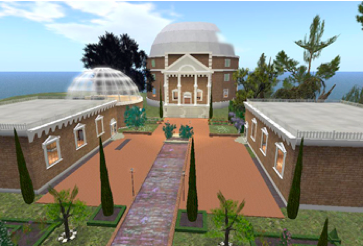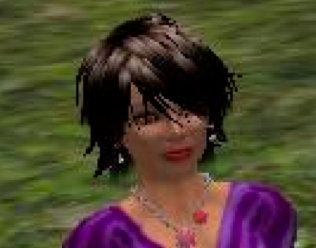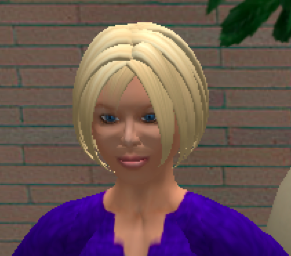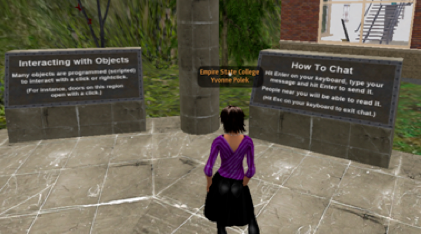HETL Note: We are pleased to publish this informative feature article contributed by Dr. Susan Oaks, Ph.D. The author presents the design of a course that incorporates Second Life as a non-compulsory option in an introductory business communications course, offering an active learning experience to the perceptive audience of a net-generation class. If you would like to share your own experiences with Second Life or other Web 2.0 based educational approaches, you may submit your own article on the topic or you may submit a “letter to the editor” of less than 500 words (see the Submissions page on this portal for submission requirements).
 Author’s Bio: Dr. Susan Oaks is Professor at the Center for Distance Learning, Empire State College, where she is responsible for designing and teaching online writing and literature courses. She won a SLOAN-C award for Excellence in Online Teaching, a State University of New York Chancellor’s award for Excellence in Teaching, and an Empire State College award for Excellence in Mentoring. In 2009-2010, she was named Susan H. Turben Chair in Mentoring. Dr. Oaks co-developed an award-winning online writing center. Her research interests include online course design, teaching writing online, and mentoring adult students. She has a Ph.D. from New York University, an M.A. from the State University of New York at Albany, and a B.A. from Elmira College. Dr. Oaks can be reached at [email protected]
Author’s Bio: Dr. Susan Oaks is Professor at the Center for Distance Learning, Empire State College, where she is responsible for designing and teaching online writing and literature courses. She won a SLOAN-C award for Excellence in Online Teaching, a State University of New York Chancellor’s award for Excellence in Teaching, and an Empire State College award for Excellence in Mentoring. In 2009-2010, she was named Susan H. Turben Chair in Mentoring. Dr. Oaks co-developed an award-winning online writing center. Her research interests include online course design, teaching writing online, and mentoring adult students. She has a Ph.D. from New York University, an M.A. from the State University of New York at Albany, and a B.A. from Elmira College. Dr. Oaks can be reached at [email protected]
Patrick Blessinger and Krassie Petrova
~~~~~~~~~~~~~~~~~~~~~~~~~~~
Real Learning in a Virtual World:
Incorporating Second Life in a Professional Communications Course
Susan Oaks
State University of New York, USA
Abstract
Second Life has been used as a tool for post-secondary education over the past few years. A virtual world such as Second Life adds the ability to enhance learning through interaction and exploration, ways of learning that are important to Net Generation learners. Second Life offers the chance to create a rich, constructivist approach to learning about professional communications as it supports interaction on a visual, emotional level that is appropriate to a course that deals with communication. Most importantly, Second Life offers a visible, concrete way of presenting abstract communication concepts that students traditionally struggle with, concepts such as “audience” and “communication context.” This paper examines the decision to include a Second Life experience in a professional business communications course as a way of learning about communication theory in action and discusses key issues related to implementing Second Life in this course re-design.
Introduction: What is Second Life?
Second Life is a virtual world in which users create avatars and interact via those avatars in real-time, in a variety of environments and ways. Many types of environments have been constructed by Second Life users to support these interactions: college campuses, performance venues, science labs, and businesses.
 In addition to creating campus locations for students and faculty to gather and interact, educators have used Second Life for simulations, virtual tours, and other visual and group-based learning activities (e.g., science and medical simulations, a tour of Hamlet’s castle, and a pilgrimage to Mecca).
In addition to creating campus locations for students and faculty to gather and interact, educators have used Second Life for simulations, virtual tours, and other visual and group-based learning activities (e.g., science and medical simulations, a tour of Hamlet’s castle, and a pilgrimage to Mecca).
Essentially, Second Life allows users to create a persona (human, animal, or something in between), locate that persona in a specific environment, and communicate with others who are in that same environment at the same time. The persona is visually represented by its avatar.
 A study by Bowers et.al. (2009) asserted that “across all uses of Second Life in their curricula, most instructors reported an above average level of perceived enhancement in student learning” (p. 47). Kolowich (2010) quotes Douglas Hersh, an instructor who studied visual and aural presence in online courses, who found that “students feel more satisfied in their online courses when they feel engaged through human presence design….students who find intrinsic satisfaction in their human presence courses tend to complete them at higher rates and with higher levels of academic success.”
A study by Bowers et.al. (2009) asserted that “across all uses of Second Life in their curricula, most instructors reported an above average level of perceived enhancement in student learning” (p. 47). Kolowich (2010) quotes Douglas Hersh, an instructor who studied visual and aural presence in online courses, who found that “students feel more satisfied in their online courses when they feel engaged through human presence design….students who find intrinsic satisfaction in their human presence courses tend to complete them at higher rates and with higher levels of academic success.”
Despite the positive results of these studies, there are potential problems with using Second Life as an educational venue. It’s not intuitive, especially for users who are not technically inclined. It contains many types of environments, some of which (e.g., adult-themed) are inappropriate for educational and professional uses. Non-student avatars may appear in student locations, and some of those avatars manipulate and even act aggressively toward others, similar to what might happen in a video game. Young (2010) detailed some of the problems with Second Life in an article in The Chronicle of Higher Education.
As we considered Second Life, we decided to try to deal proactively with these potential problems. We identified some appropriate places to visit and stated clearly that there were inappropriate places. We embedded user information and constructed Second Life activities within the course, and we hired an on-call “expert” in Second Life to help students who wanted to use this medium. Because Second Life offers human presence through participants’ avatars, it seemed to offer an interesting way to help students learn about communication theory in action. We felt that this was worth exploration.
This paper discusses key issues related to thinking through and incorporating a Second Life experience in a re-designed online course in business communications. These include: 1) instructor purpose and student learning needs, 2) usability and scaffolding – how to make the virtual world accessible, and 3) technical support.
Instructor Purpose and Student Learning Needs
The course for which Second Life seemed appropriate was Communications for Professionals, an introductory-level business communications course. The course had been offered for years, with its content evolving as modes and styles of communication have evolved in professional environments. The purposes of the course are many – to teach basic communication theory, to make students more familiar with current communication media that they might encounter on the job now and in the near future, to help students understand that communication is a collaborative process, and to help students better understand the more abstract concepts related to the communication process such as “audience” and “communication context” (concepts with which students in the course have traditionally struggled).
 Second Life appeared to offer one way to address these purposes, especially the last two of collaboration and audience /context. The hope was that students would understand the abstract concepts of audience and context more easily when dealing with them in a visual, concrete, immediate way, rather than through asynchronous text. We also hoped that the visually interesting, playful way of collaborating offered through Second Life would support students partnering on a project. Traditionally, it has been difficult to get students to work together, and one of the course purposes was to foster collaboration on communications, thereby developing a valuable workplace skill.
Second Life appeared to offer one way to address these purposes, especially the last two of collaboration and audience /context. The hope was that students would understand the abstract concepts of audience and context more easily when dealing with them in a visual, concrete, immediate way, rather than through asynchronous text. We also hoped that the visually interesting, playful way of collaborating offered through Second Life would support students partnering on a project. Traditionally, it has been difficult to get students to work together, and one of the course purposes was to foster collaboration on communications, thereby developing a valuable workplace skill.
In choosing to experiment with Second Life, we also looked at our audience of learners. Empire State College, part of the State University of New York, mainly serves adult students. Many students are in their mid-30s, and the online program at the college’s Center for Distance Learning attracts students who generally understand and use basic computer technology at work and at home. Although many of our students have not yet investigated Second Life, they often have used some sort of social media or played interactive computer games. As they are among the first wave of the Net Generation, born in the mid-to-late 1970s and early 1980s, they are comfortable with the asynchronous course format that is the standard mode of delivery for most of our online courses.
Courses, though, need to take into account the Net Generation’s needs as learners, as described by multiple authors referred to in Oblinger and Oblinger (2005). Roberts (2005) focuses on the need to use technology to highlight important concepts, and “the ability to customize the class using the current technology available.” Windham (2005) explains general characteristics of Net Generation learners: interaction, exploration, relevancy, multimedia and the desire for online instruction. Brown (2005) explains that “Net Generation students are achievement and goal oriented. Their question is not ‘What does it mean?’ or ‘How does it work?’ (as previous generations were inclined to ask), but rather ‘How do I build it?’. This predilection maps to learning theory’s emphasis on active learning. Discovery, exploration, experimentation, criticism and analysis all represent active learning, a style that suits the Net Generation well.”
Second Life had the possibility of adding the interactive, exploratory elements important to Net Generation learners. Second Life contributed immediacy and emotional and visual elements to the learning space, elements that are present in real-time professional communications at work, but that are difficult to deal with in an active, applied way within the context of an asynchronous, text-based course. As stated in The Horizon Report (2007), “virtual worlds offer an opportunity for people to interact in a way that conveys a sense of presence lacking in other media. These spaces…combine many of the elements that make Web 2.0 really exciting: social networking, the ability to share rich media seamlessly, the ability to connect with friends, a feeling of presence, and a connection to the community” (p. 18). So, the choice of a virtual world such as Second Life was logical, given student learning needs and instructional purposes.
Choosing Learning Activities and Making them Usable: Scaffolding and Learning in Second Life
The questions then turned to emphasis and accessibility. How much of the course should be devoted to teaching using this one technology? How accessible would the technology be to students? How can communication concepts come to the forefront while the technical aspects of Second Life are downplayed, so that learning about communication remains the emphasis in the virtual environment? And just what learning tasks would make sense?
As Middleton and Mather (2008) state,
…media intervention methodology…encourages academics to view digital media objects as simple resources deployed with the intention of promoting active, student-centered learning designed to set challenges, seed ideas, or illustrate problems so as to quickly engage and affect the learner (p. 208).
Middleton and Mather also assert that using digital media successfully depends upon “ease of production and integration” (p. 208).
Two publications helped in thinking through these questions and concepts on a more concrete level, 1) Conklin’s 101 Uses of Second Life in the College Classroom (2007), to spark ideas about feasible activities, and 2) Understanding Learning Archetypes for 3D Learning (n. d.), to verify purposeful activities given the learning goals of the course.
In Understanding Learning Archetypes for 3D Learning, eight archetypes are identified specific to the learning context of virtual worlds: 1) classroom emulation, 2) role-plays, 3) treasure/scavenger hunts, 4) guided tours, 5) conceptual orienteering, 6) operational application, 7) co-creation, and 8.) critical incident. Of these, conceptual orienteering, co-creation, critical incident, and operational application are appropriate to the learning goals of the communications course – to learn how to create actual communications appropriate to audience and context, and to learn how to collaborate on these communications.
Further, conceptual orienteering is defined as:
…providing the learner with examples and…allowing the learner to determine the attributes that describe the concept….The process of side-by-side comparison allows learners to recognize and apply concepts in a variety of different environments….The goal is to provide a visualization of the differences to the learner who can then determine what attributes apply to the concept and what attributes do not. The learners can visually see attributes and do a mental comparison through the ability to instantly move from one location to another (Conceptual Orienteering section, para. 1-2).
One early Second Life activity is to have students read about the concept of culture as the context within which communication occurs, have them consider various real-life cultures of which they are a part, and then introduce them to Second Life to enhance the concept of cultural context. Students are introduced to Second Life by watching a video and by reading articles about Second Life groups and cultures. Students are asked to debate whether Second Life fits their textbook definition of “culture.” By actually seeing the differences between “real” and Second Life groups, and by seeing the differences among groups within Second Life, the hope is that students will more immediately understand that there are multiple contexts within which communication occurs. Discovering and remembering the concept of context, introduced by a consideration of culture, can be more real to the student because of the visual impact of Second Life.
Operational application, in which “the learner is challenged to apply rules to specific situations…. is ‘learning by doing’ in the virtual environment…. It is practice for what happens on the job.” (Understanding Learning Archetypes for 3D Learning, n. d.) Students in the course are asked to learn by doing – to apply their understanding of culture and context to communication assignments throughout the course. Students are required to do a situational analysis for each communication task, identifying their audience and communication context for each piece of communication. Additionally, students who pursue the Second Life option are asked to learn Second Life by completing a number of small tasks for which there is help both within the course (in written form) and through personalized staff support as needed.
The last two archetypes in (Understanding Learning Archetypes for 3D Learning, n. d.) are ‘co-creation’ and critical incident ‘. Different types of learning activities culminate in a critical incident, the archetype in which:
…the learner is placed into an environment or situation similar to the real event in which they [sic] must use their [sic] prior knowledge to solve a problem….The learning in this environment would be within both the affective and cognitive learning domains (Critical Incident section, para. 16).
While co-creation occurs throughout the course as students collaborate on various writing tasks, a critical incident occurs toward the end of the course via a three-week project that asks students to plan and host a real-time Second Life arts event showcasing the creative work of students in an online photography course. The Communications students are expected to identify the communications they need, create appropriate messages, contact participants, coordinate the event, market it to various groups within Second Life who may want to attend the event, and get background on the art works and artists so they can help host the event. Their work culminates in a portfolio of professional communications that are germane to this activity. Learning objectives relate to planning and coordinating, motivation, and teamwork, as well as communication. Again, students need to articulate collaboratively and apply concepts of audience and context in order to create and host a successful event.
A decision was made not to offer the entire course in Second Life, because that required more of a focus on the technology rather than on communication concepts at the start of the course, and because one of the course purposes was also to have students become familiar with a variety of communication media. So a blog, wiki, and presentation tools (such as VoiceThread) were chosen for various collaborative and presentation work. Instead of a complete course in Second Life, students initially get involved in this virtual world on a very introductory level, as they investigate the concept of cultural context, and then have the choice of doing relatively quick, concrete learning activities if they choose the Second Life track throughout the course.
Most importantly, the activities in the Second Life track are simple, concrete, and structured so that students can work through them relatively easily. They culminate in an authentic learning experience, the real-time art show. Based on the work of Martinez and Matias (2009), who were the first to adopt Second Life in an Empire State College course, Second Life learning activities we designed moved from static, to more active, and then finally to interactive activities. We designed eight modules over the 15 weeks of the course to enable students to develop the skills to work on the final project in Second Life. These were:
1. Everyone – View a YouTube video on the educational uses of Second Life, to get a sense of the look of the virtual world without having to learn how to navigate it. Read about the option for doing a Second Life group activity – the art show – during the last module/last three weeks of the course.
2. Everyone – Read short articles about Second Life and discuss the concept of Second Life culture/s in terms of the text’s definition of cultural context.
3. Optional Second Life activity – Install Second Life and get your Avatar.
4. Optional Second Life activity – Create a profile in Second Life, go to the college’s location, and take a picture of your avatar there. Add the photo and profile to the Introductions blog in the course.
5. Optional Second Life activity – Visit selected locations in Second Life and share the results in the course blog.
6. Optional Second Life activity – Interact with others in Second Life and share results in the course blog.
7. Optional Second Life activity – Attend an event in Second Life and share results in the course blog.
8. Optional Second Life activity – Collaborative work on the art show showcasing the work of students in an introductory Photography course. Create all communications needed to organize and advertise the event, and be present as informed hosts at the event.
Throughout the course, students pursuing the Second Life option also have the opportunity to gather and meet in Second Life.
All of these learning activities are appropriate to the purpose of and audience for this professional communications course. But can the Second Life learning activities succeed in this structured format, given both the instructors’ and students’ need to learn Second Life’s specific technology? Technical learning is a real concern, especially for students at a distance who have very different levels of expertise. Faculty as well have different comfort levels with technology, and are also not expected to answer technical questions or solve technical problems. So the need to address the technology question always was present.
Technical Issues and Ways of Addressing Them
In order to cut down on technical support, a decision was made to standardize support material as much as possible. Martinez and Matias (2009) created documentation accessible and geared toward our student population. In addition to creating documentation for the structured learning activities, Martinez and Matias created a comprehensive Orientation to Second Life document, which includes sections defining Second Life, a Quick Start Guide, a Second Life Lexicon, Second Life Basic Skills, a Second Life Help Option, and documents on Second Life’s Life Styles, Behavior, and Cautions. All of this documentation was placed in a Resource section within the course. Additionally, they also created a cyborg tour to help students walk through the simple tasks they need to learn in Second Life. The hope is that the abundance and easy availability of help, along with the targeted and accessible nature of that help, will cut down on technical emergencies and walk students through the activities they need to learn with a minimum of real-time support.
 For students who opt to do the final project in Second Life, we are using an art presentation space built for the college, with pre-set frames for photographs and documentation enabling students to mount a photograph in a frame with a few “clicks.” Students are not expected to build in Second Life, or to deal with more complicated technical tasks. They are only expected to learn the basics – to get their avatar, find a location, take a photo, and interact with others. The emphasis, again, is on the learning and application of communication concepts in an emerging communication medium, which is just one medium of many.
For students who opt to do the final project in Second Life, we are using an art presentation space built for the college, with pre-set frames for photographs and documentation enabling students to mount a photograph in a frame with a few “clicks.” Students are not expected to build in Second Life, or to deal with more complicated technical tasks. They are only expected to learn the basics – to get their avatar, find a location, take a photo, and interact with others. The emphasis, again, is on the learning and application of communication concepts in an emerging communication medium, which is just one medium of many.
In addition to building Second Life into the course and in consideration of students’ individual learning styles and technical expertise, students can also choose to pursue comparable learning activities that require a lower level of technical expertise. For example, students may opt to work on a real professional or community project individually or collaboratively, using asynchronous communication tools. They may opt to do a similar group project using other visual media, and not Second Life. The instructional task is to choose comparable course activities for equity of learning opportunity and assessment – for example, by offering traditional communications (mostly written text), new media learning activities (blog, wiki, a VoiceThread presentation, social media Web sites such as FaceBook), as well as Second Life learning activities.
Conclusion
This paper detailed the thinking behind a decision to implement Second Life in a communications course. We are just starting to gather data on its use. The hope is that Communications for Professionals will successfully address student learning needs and instructor and course learning goals through a rich online learning environment that incorporates the virtual environment of Second Life. According to Whitton and Hollins (2008),
…immersive virtual learning environments can provide the opportunity for learners to explore and navigate worlds using a range of media types, with authentic and purposeful contexts for practicing learning that can be transferred to the real world, and they can present a context for problem-solving and interaction with others (p. 222)
Second Life provides an opportunity to incorporate real-time, social and professional activities into asynchronous online course activities, which can address some students’ preferred ways of learning. The hope is that Second Life can support the learning goals of the course by offering a rich constructivist environment.
References
Bowers, K. W., Ragas, M. W., & Neely, J. C. (2009). Assessing the value of virtual worlds for post-secondary instructors: A survey of innovators, early adopters and the early majority in second life. International Journal of Humanities and Social Sciences, 3 (1), 40-50. Retrieved from http://www.waset.org/journals/ijhss/v4/v4-5-45.pdf
Brown, M. (2005). Learning spaces. In Oblinger, D., & Oblinger, J. (Eds.), Educating the Net Generation. EDUCAUSE E-Book. Retrieved from http://www.educause.edu/Resources/EducatingtheNetGeneration/LearningSpaces/6072
Conklin, M. (2007). 101 Uses of Second Life in the College Classroom. Version 2.0 February 25, 2007. doi: 10.1.1.133.9588.pdf
The Horizon Report. (2007). The New Media Consortium and EDUCAUSE Learning Initiative. Retrieved from http://www.nmc.org/pdf/2007_Horizon_Report.pdf
Kolowich, S. (2010). The Human Element. Inside Higher Education (March 29, 2010). Retrieved from http://www.insidehighered.com/news/2010/03/29/lms
Martinez, N., & Matias, A. (2009). The future of being human: a science course with a second life learning activity. Paper presented at the Sloan Emerging Technologies for Online Learning Conference. Retrieved from http://www.slideshare.net/Nicola.Martinez/the-future-of-being-human-a-science-course-with-a-second-life-learning-activity
Middleton, A. J., & Mather, R. (2008). Machinima interventions: Innovative approaches to immersive virtual world curriculum integration. ALT-J Research in Learning Technology, 16 (3), 207-220.
Oblinger, D., & Oblinger, J. (2005, Eds). Educating the Net Generation. EDUCAUSE E-Book. Retrieved from http://www.educause.edu/educatingthenetgen
Roberts, G. (2005). Technology and learning expectations of the net generation. In D. Oblinger, & J. Oblinger (Eds). Educating the Net Generation. EDUCAUSE E-Book. Retrieved from http://www.educause.edu/Resources/EducatingtheNetGeneration/TechnologyandLearningExpectati/6056
Understanding Learning Archetypes for 3D Learning. (n.d.). Retrieved from http://msitsecondlife.wikispaces.com/page/pdf/Learning+Archetypes
Whitton, N. , & Hollins, P. (2008). Collaborative virtual gaming worlds in higher education. ALT-J Research in Learning Technology, 16 (3), 221-229.
Windham, C. (2005). The student’s perspective. In D. Oblinger, & J. Oblinger (Eds). Educating the Net Generation. EDUCAUSE E-Book. Retrieved from http://www.educause.edu/Resources/EducatingtheNetGeneration/TheStudentsPerspective/6061
Young, J. (2010). After frustrations in second life, colleges look to new virtual worlds. The Chronicle of Higher Education. Retrieved from http://chronicle.com/article/After-Frustrations-in-Second/64137
Suggested Citation:
Oaks, S. (2011). Real Learning in a Virtual World. The International HETL Review. Volume 1, Article 3, https://www.hetl.org/feature-articles/real-learning-in-a-virtual-world/
Copyright © [2011] Susan Oaks
The author(s) assert their right to be named as the sole author(s) of this article and the right to be granted copyright privileges related to the article without infringing on any third party rights including copyright. The author(s) retain their intellectual property rights related to the article. The author(s) assign to HETL Portal and to educational non-profit institutions a non-exclusive license to use this article for personal use and in courses of instruction provided that the article is used in full and this copyright statement is reproduced. The author(s) also grant a non-exclusive license to HETL Portal to publish this article in full on the World Wide Web (prime sites and mirrors) and in electronic and/or printed form within the HETL Review. Any other usage is prohibited without the express permission of the author(s).




